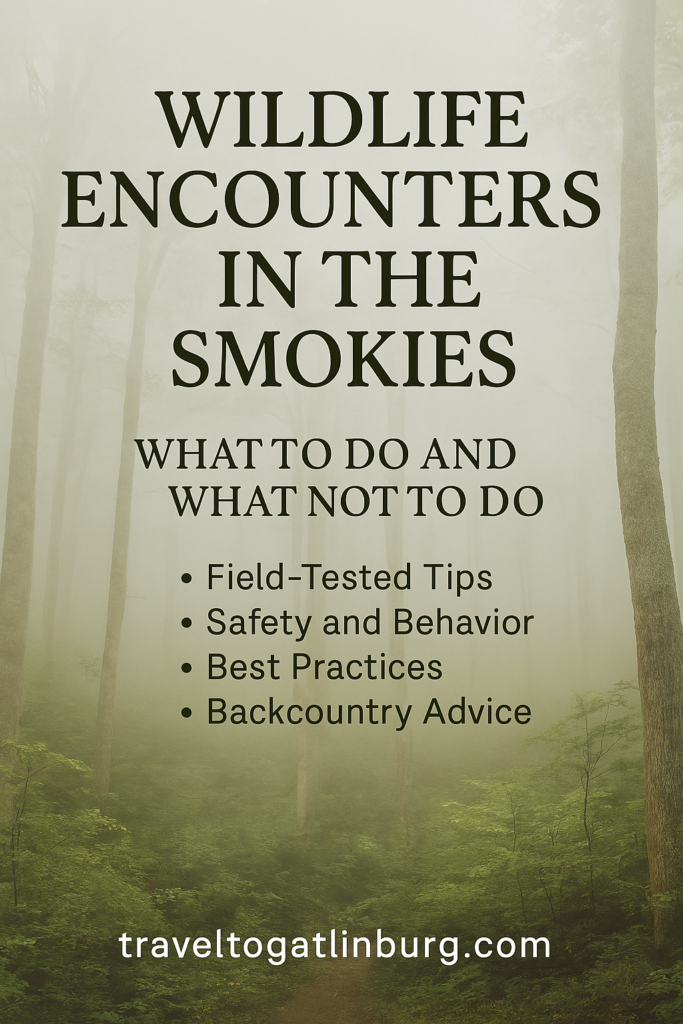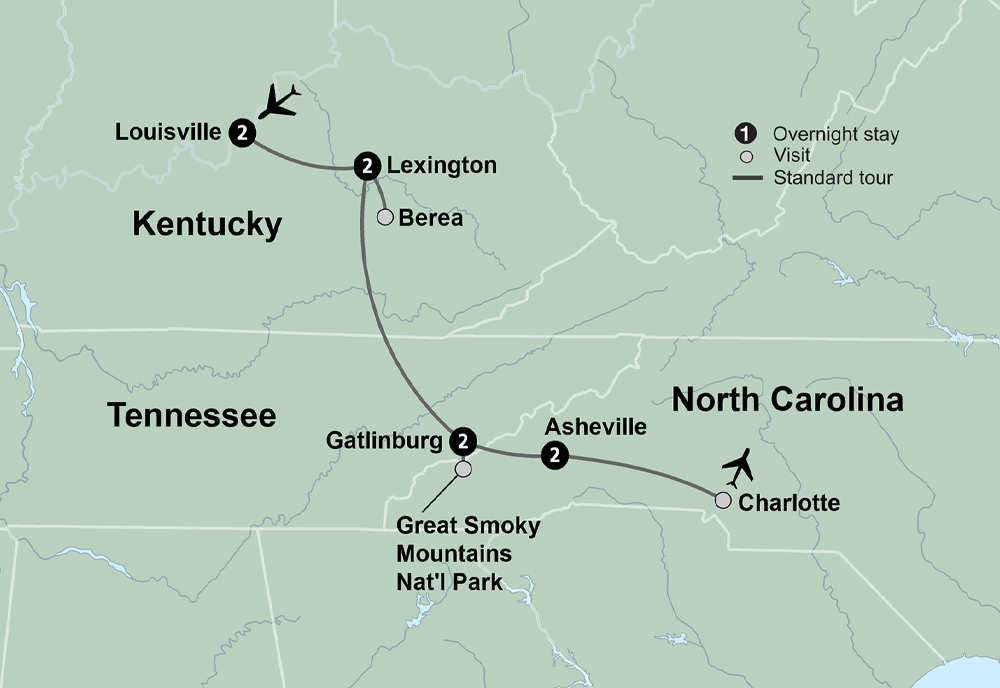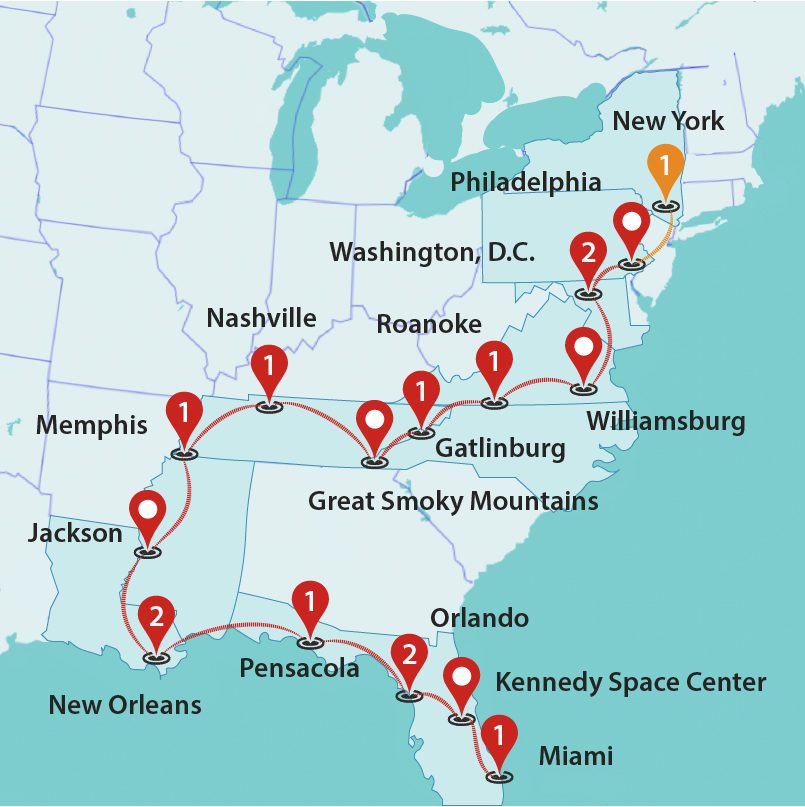A Field Guide for Staying Safe—and Savoring the Wild—Like a True Explorer
Into the Wild of the Smokies
There’s a wild heartbeat beneath the quiet of the Great Smoky Mountains. It pulses through the dense forests, echoes across misty ridges, and stirs the underbrush where bears roam and elk graze. For every visitor drawn to these mountains by their beauty, there’s another drawn by the thrill—the chance to cross paths with something untamed.
But here’s the thing about the wild: it doesn’t follow your rules. And if you’re not prepared—truly prepared—you can find yourself in trouble faster than you’d believe.

The Smokies are home to over 65 species of mammals, 200 varieties of birds, and an array of reptiles, insects, and amphibians. Black bears are the stars of the show, sure—but they’re not alone. Elk, wild boar, bobcats, coyotes, and even venomous snakes share these woods. And they don’t always keep their distance.
That’s why this guide isn’t just about seeing wildlife. It’s about encountering it safely, smartly, and with respect. You don’t need to be a survival expert—you just need a bit of field-tested wisdom, a clear head, and the right gear.
And if you’re serious about giving yourself the best shot at a wildlife experience without the chaos of traffic or long morning drives, staying close to the park can be your smartest move of all. Find a cozy basecamp right here in Gatlinburg—close enough for sunrise sightings, but far enough from trouble.
This isn’t just another nature walk. It’s the Smokies. And here, nature walks you.
The Wildlife You Might Encounter (And What Makes Each Unique)
When you step into the Smokies, you’re stepping into one of the most biologically rich ecosystems in North America. It’s not a question of if you’ll encounter wildlife—it’s when, where, and how close. Knowing what’s out there isn’t just smart—it’s essential.
Black Bears
Let’s start with the undisputed kings of the Smokies—black bears. These magnificent creatures are surprisingly common, with over 1,500 estimated in the park. They’re most active at dawn and dusk, particularly in spring and fall. Most of the time, they’ll keep their distance. But make no mistake: if food is involved, or if you get too close, things can turn fast. Their sense of smell is seven times stronger than a bloodhound’s.
Elk
Massive and majestic, elk were reintroduced into the park in 2001 and now thrive in places like Cataloochee Valley and the Oconaluftee area. Bulls can weigh over 700 pounds and carry enormous antlers. During mating season (the rut), they can be aggressive—especially if you get between them and their harem. Give them space. A lot of it.
Wild Boar
The feral pig population in the Smokies is less glamorous and more dangerous. These animals are fast, unpredictable, and can become aggressive if cornered. They tend to stick to remote areas, but if you see one—especially with piglets—back away. Slowly. No sudden moves.
Snakes
You’ll find 23 species of snakes in the Smokies, but only two are venomous: the timber rattlesnake and the northern copperhead. Both prefer to avoid humans. Copperheads are well-camouflaged and bite when stepped on. Learn what they look like—and wear boots when hiking deep trails.
Other Creatures Worth Knowing
Coyotes are shy but clever. Bobcats are elusive but powerful. You may hear them at night but rarely see them. Wild turkeys, deer, and raccoons are common and usually harmless—unless fed. That’s when they become pests and pose risks to themselves and others.
The wild doesn’t follow a script, and no two encounters are alike. But every animal in the Smokies gives you clues—if you know how to read them.
And if you’re hoping to spot wildlife early in the morning or near dusk—prime time for movement—you’ll want to be close to the action. Here’s where you can stay nearby, and give yourself the best chance at something unforgettable.
What To Do During a Wildlife Encounter
The wild doesn’t announce itself—it just arrives. One moment you’re enjoying a quiet trail, and the next, you lock eyes with a 250-pound black bear or a bull elk with a rack as wide as a doorway. What you do next could mean the difference between a story to tell and a situation to survive.
Stay Calm
Easier said than done, right? But panic is your worst enemy. Animals pick up on tension, sudden movement, and high-pitched sounds. If your heart’s pounding, that’s fine—but keep your voice low, your arms relaxed, and your posture steady.
Make Yourself Known—Not Threatening
For black bears, the goal is to show you’re human, not prey. Speak softly, wave slowly, and back away without turning your back. Make yourself appear large without lunging or shouting. Bears don’t want a fight—they want to be left alone.
Give Them Room to Move
Wild animals don’t like being cornered. Step aside slowly. If you’re on a trail, move off and give the animal a path of escape. Never, under any circumstances, try to get closer for a photo. That’s how people get hurt—and how animals get euthanized.
Protect Your Food—Always
Leaving food out in the open is like ringing a dinner bell in the woods. Keep snacks sealed, pack out every wrapper, and use bear-proof bins when provided. If you’re hiking, a bear canister isn’t optional—it’s essential.
Know When to Hold Your Ground
If a bear starts to follow you or bluff charges (a short run to test you), stand your ground. Shout. Raise your arms. Make noise. Most of the time, they back off. But don’t run. Running triggers a predator response—even from animals that weren’t hunting to begin with.
Every encounter is different, and nature doesn’t hand out rulebooks. But when you move with respect and awareness, you dramatically increase your chances of walking away with nothing but a good story.
And if you’re the kind of traveler who wants to be first on the trail and last to leave the ridge, you’re going to want a home base that’s as close to the wild as you are. Here’s where to stay if you want the Smokies at your doorstep.










What Not to Do (If You Value Safety—and Sanity)
Nature has its rules. Break them, and the wild will teach you the hard way. These mountains are full of awe, but also consequence. If you want to come back with memories instead of mistakes, there are a few things you absolutely must avoid.
Don’t Feed the Animals
It doesn’t matter how cute the bear cub looks, how curious the raccoon acts, or how close that deer wanders—do not feed them. It’s illegal, dangerous, and often a death sentence for the animal. A fed bear becomes a bold bear, and bold bears get removed or put down. Feeding them turns wild animals into beggars, and that never ends well.
Don’t Run
This one’s instinctive, but deadly. Whether it’s a bear, a wild boar, or a protective elk, turning your back and running kicks their instincts into high gear. Prey runs. You’re not prey. Stand your ground, look big, and back away slowly—always facing the animal.
Don’t Approach for a Better Photo
You’re not a wildlife photographer on assignment. You’re a visitor in someone else’s home. The difference between a 30-yard zoom shot and a 10-yard close-up could be the difference between a keepsake and an injury. If your phone can’t zoom far enough, enjoy the moment and let it live in memory.
Don’t Leave Food or Trash Behind
Even a granola bar wrapper or apple core can lead animals to associate humans with food. It starts with one hiker leaving a snack and ends with a bear raiding a campsite. What you leave behind can ripple through the ecosystem in ways you never see—but the animals will.
Don’t Assume You’re Safe Just Because It’s Daylight
Some of the worst encounters happen in the middle of the afternoon. Black bears especially don’t keep strict hours. They follow food, water, and shelter—whatever the clock says.
True Story: One Step Too Close
A family once spotted a bull elk near Oconaluftee, standing in a misty field. Dad stepped forward to get a better angle. He didn’t see the second bull behind a clump of trees. One charge later, he was lucky to walk away with bruises. That close-up cost him a hospital visit—and a hefty fine from park rangers.
Wildlife encounters can be magical. They can also be dangerous. The difference lies in the decisions you make. Out here, respect isn’t optional—it’s survival.
Best Practices for Hikers, Campers, and Families
The Smokies are no place for guesswork. Whether you’re setting out on a solo hike, wrangling toddlers through the woods, or pitching a tent under the stars, the best defense is solid preparation. Out here, it’s not just about how far you go—it’s how smart you are while doing it.
Secure Your Food the Right Way
Every camper and backpacker needs to understand one thing: if it smells, it attracts. Use bear-proof containers or hang your food at least 10 feet off the ground and 4 feet from the trunk of a tree. This goes for snacks, toothpaste, deodorant—anything with a scent. Don’t leave it in your tent, and don’t leave it in your car if you’re near a known bear corridor.
Hike in Groups Whenever Possible
There’s strength in numbers. Bears are less likely to approach a group of hikers, and if something does go wrong, someone’s there to help or call for backup. Stick together, and make casual noise as you go. It helps alert wildlife without disrupting the peace.
Carry Bear Spray—and Know How to Use It
This isn’t just a “nice-to-have.” Bear spray is essential. Keep it on your belt or backpack strap, not buried inside your bag. Know how to unlock and discharge it. Practice if needed. When a bear’s closing the distance, you won’t have time to read the label.
Leash Your Dog—And Don’t Let Kids Wander
Dogs can provoke wildlife, even unintentionally. If a bear sees your dog as a threat, it won’t hesitate. Keep pets on a leash and children within arm’s reach. Teach kids basic animal safety: no running, no shouting, and no approaching animals—no matter how friendly they seem.
Pack for the Worst, Hope for the Best
Out here, a dead phone is just dead weight. Always carry a paper map of the trail, a flashlight with backup batteries, a whistle, and a small first aid kit. Cold weather? Pack an emergency blanket. Sudden rainstorm? A compact poncho goes a long way.
Choose Trails That Fit Your Group’s Abilities
Overestimating your stamina—or your gear—can lead to bad decisions fast. Choose trails with your slowest hiker in mind, and always let someone know where you’re headed before you set off.
And remember: comfort at the end of the day matters, too. Whether you’re a hiker recharging for round two or a family just needing hot cocoa and soft beds, you’ll find lodging nearby that keeps the wild close—and the worries far away.
Preparation isn’t just smart—it’s what transforms a risky situation into a remarkable story of adventure.










Signs an Animal Is Stressed (And When to Back Off Immediately)
Animals don’t speak our language—but they do communicate. And if you’re out in the Smokies, one of the most critical skills you can develop is the ability to read the signs. Recognizing when an animal is uneasy, agitated, or ready to defend itself can mean the difference between a magical sighting and a serious emergency.
Black Bears: Bluff or Real?
A bear standing on its hind legs isn’t necessarily aggressive—it’s usually trying to get a better look or scent. But if it starts pacing, huffing, jaw-popping, or slapping the ground with its paws, that’s a warning. The next move could be a bluff charge—or the real thing.
Your move? Hold your ground. Speak firmly. Slowly back away. And don’t turn and run.
Elk: Graceful Giants With Zero Tolerance
During the fall rut, male elk are on edge. If you see a bull elk lower its head, paw the ground, bugle, or start weaving its antlers from side to side—back off. Fast. A charging elk can cover ground quicker than you expect, and those antlers aren’t just for show.
Female elk with calves are equally protective. If they pin their ears or stomp—respect the distance. Never come between a mother and her young.
Snakes: Silent But Clear
Most snakes, venomous or not, would rather avoid you. But if a snake coils, flattens its head, vibrates its tail, or hisses, you’re too close. Stop moving, scan your surroundings, and slowly take a few steps back. Don’t poke, prod, or try to shoo it away.
Wild Boar: The Sudden Storm
Boars often give little warning before charging, but if they begin snorting, pawing at the ground, or tossing their heads, you’re in the danger zone. Don’t make eye contact. Back away slowly, keeping your posture neutral.
General Rule of the Wild: If You’re Not Sure, Assume It’s a Warning
Animals don’t fake signals. If their body language shifts from calm to tense—if they stop eating, freeze mid-step, or stare directly at you—they’re alert to your presence. That’s your cue to disengage.
The goal isn’t just to avoid harm—it’s to avoid causing stress. A respectful retreat keeps both you and the animal safe.
When to Call for Help (And Who to Call)
Even the best-prepared adventurers run into trouble. The key difference? They know when to call for help—and how to do it quickly and effectively. Out in the Smokies, communication can be patchy, and timing can be everything. If you encounter a dangerous situation involving wildlife, it’s not about bravado—it’s about smart decision-making.
When Should You Call for Help?
- A bear or elk is acting aggressively and won’t retreat.
- You’ve witnessed someone being injured by wildlife.
- An animal is showing abnormal behavior—staggering, foaming at the mouth, or approaching humans without fear.
- You’re lost and disoriented with no clear exit path.
- You’ve had a close encounter that has left you shaken and unsure how to proceed.
Who Do You Call?
- Emergencies (injury, active threat): Call 911 immediately.
- Non-emergency wildlife issues: Contact the National Park Service (NPS) dispatch at:
- 865-436-1230 (available 24/7)
- Lost but not in danger? Use the NPS non-emergency line or, if available, report via a ranger station or visitor center.
What Information Should You Provide?
- Your exact or approximate location (use trail markers, GPS, landmarks)
- Time and nature of the incident
- Number of people involved
- Description of the animal’s behavior
- Whether medical assistance is needed
Stay Put or Move?
- If you’re injured or unsure of your direction, stay put in a visible, open area.
- If it’s unsafe to stay (i.e., you’re near a wild animal or hazard), move calmly and deliberately to higher ground or a clear trail.
- Leave markers or bright clothing to make yourself easier to spot.
Prepare for the Worst—So It Doesn’t Happen
- Before every hike, leave your route and estimated return time with someone off-site.
- Carry a whistle (three short blasts = distress).
- Download offline maps or carry a printed trail guide.
- Keep your phone fully charged—but don’t rely on it as your only lifeline.
The wild respects preparation. So does survival. Don’t be afraid to call for help—but don’t make calling for help your only plan.
What Makes the Smokies Special for Wildlife Lovers
There are national parks… and then there’s the Smokies.
This isn’t just another patch of protected land—it’s a living, breathing world where ecosystems collide and creatures thrive. The Great Smoky Mountains National Park is one of the most biodiverse places in North America, home to over 19,000 documented species—and likely tens of thousands more yet to be discovered.
It’s a Place of Rare Moments
Where else can you watch a bear cub scale a tree in the morning mist, then stand in silence as a bull elk calls out through a valley of golden light? Where can you hike a trail in the hush of dawn and spot a fox dart across your path—or hear the distant drumming of a woodpecker just as the fog lifts?
These aren’t experiences you plan—they’re moments that find you when you’re quiet, patient, and prepared.
Seasons Change the Wild
Spring brings black bears out of hibernation. Summer is rich with songbirds, butterflies, and reptiles warming themselves on rocky ledges. Fall unveils the spectacle of the rut and migrations. Winter, though still, isn’t silent—tracks in the snow tell stories no human ever witnesses.
Each visit to the Smokies holds a different rhythm, a different cast of characters. No two wildlife encounters are ever the same.
And here’s the truth: the closer you are to it all, the more likely you are to experience something unforgettable. Stay near the park’s edge, and the wild may just come to your doorstep.
Because out here, the best souvenirs aren’t bought. They’re felt—in your bones, in your breath, and in the moment you realize you’ve locked eyes with something truly wild.
Final Thoughts: Respect the Wild, and It Rewards You
The wild doesn’t need taming. It doesn’t need conquering. What it needs—what it deserves—is respect.
The Smoky Mountains aren’t a zoo. They’re alive, unpredictable, and deeply sacred. Out here, you’re not the center of the story—you’re a guest. And when you carry that mindset into every hike, every overlook, and every trailhead, the mountains reveal themselves to you in ways that can’t be captured in photos or brochures.
You’ll learn how still the forest can be when a bear passes through. You’ll feel the electric stillness before a herd of elk crests a ridge. And you’ll begin to understand what it means to coexist—not just to observe, but to belong, however briefly, in the rhythm of nature.
So pack your gear, lace up your boots, and move with intention. The Smokies don’t promise you safety—but they’ll meet you with grace if you approach them with wisdom.
And when the day winds down and your boots are muddy, your camera full, and your mind buzzing from it all, you’ll want a place to land. Choose a stay that lets you rest easy, just minutes from the wild.
Because the best wildlife encounter doesn’t end at the trail—it ends with your head on a pillow, smiling at what you saw, and grateful for what you didn’t disturb.



Leave a Reply